Let me share why I love making Dinengdeng at home. This comforting Filipino soup reminds me of my grandmother's cooking, where she would gather fresh vegetables from our backyard and grill bangus (milkfish) to perfection. The magic of this dish lies in how simple ingredients - fresh veggies, grilled fish, and our beloved bagoong isda (fermented fish sauce) - come together to create something truly special.
What makes Dinengdeng perfect for everyday cooking is that you can use whatever vegetables you have on hand, making it both practical and delicious. I make this recipe at least twice a month, and my family never gets tired of it. The light but flavorful broth, tender vegetables, and smoky grilled fish make it a complete, healthy meal that's perfect with steaming white rice. I
f you're new to Filipino cooking or looking for a healthier dish to add to your weekly menu, this recipe is a great place to start. It's budget-friendly, nutritious, and so satisfying - exactly what home cooking should be.
Jump to:
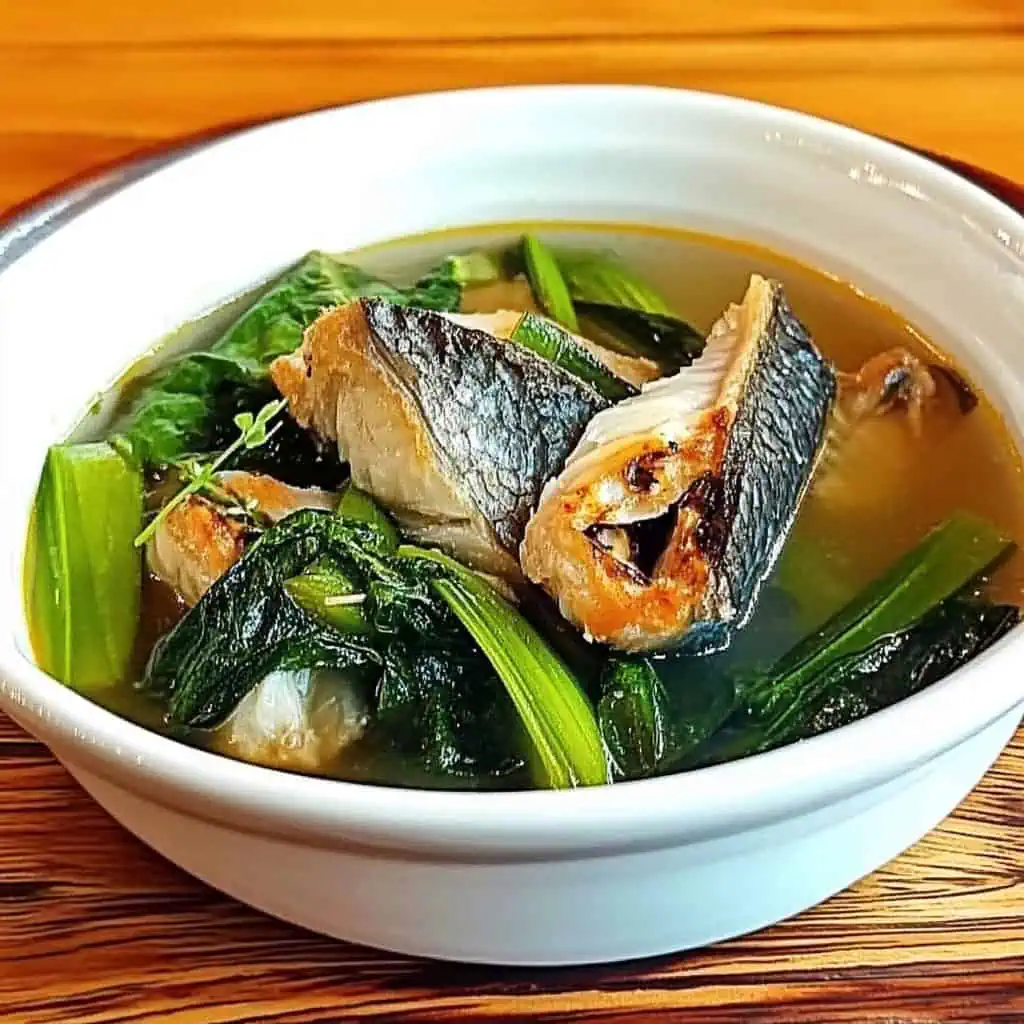
Why You'll Love This Recipe
- Farm-to-Table Freshness: Uses backyard vegetables common in Filipino homes
- Nutritious and Balanced: Packed with vegetables and lean protein
- Budget-Friendly: Makes use of readily available ingredients
- Authentic Taste: Features traditional Ilocano cooking methods
- Customizable: Can be adapted based on available seasonal vegetables
- Complete Meal: Combines protein and vegetables in one dish
Ingredients
This carefully balanced selection combines the signature elements of traditional Ilocano cooking. Grilled milkfish provides a smoky protein base, while the diverse vegetables offer complementary textures and nutritional benefits, bitter gourd for detoxification, moringa for vitamins, okra for thickening, and squash flowers for delicate sweetness.
The fermented fish sauce (bagoong isda) is the crucial flavor cornerstone, infusing the broth with authentic umami depth that cannot be replicated with modern substitutes.
Together, these ingredients create the perfect harmony of flavors that has made Dinengdeng beloved across generations.
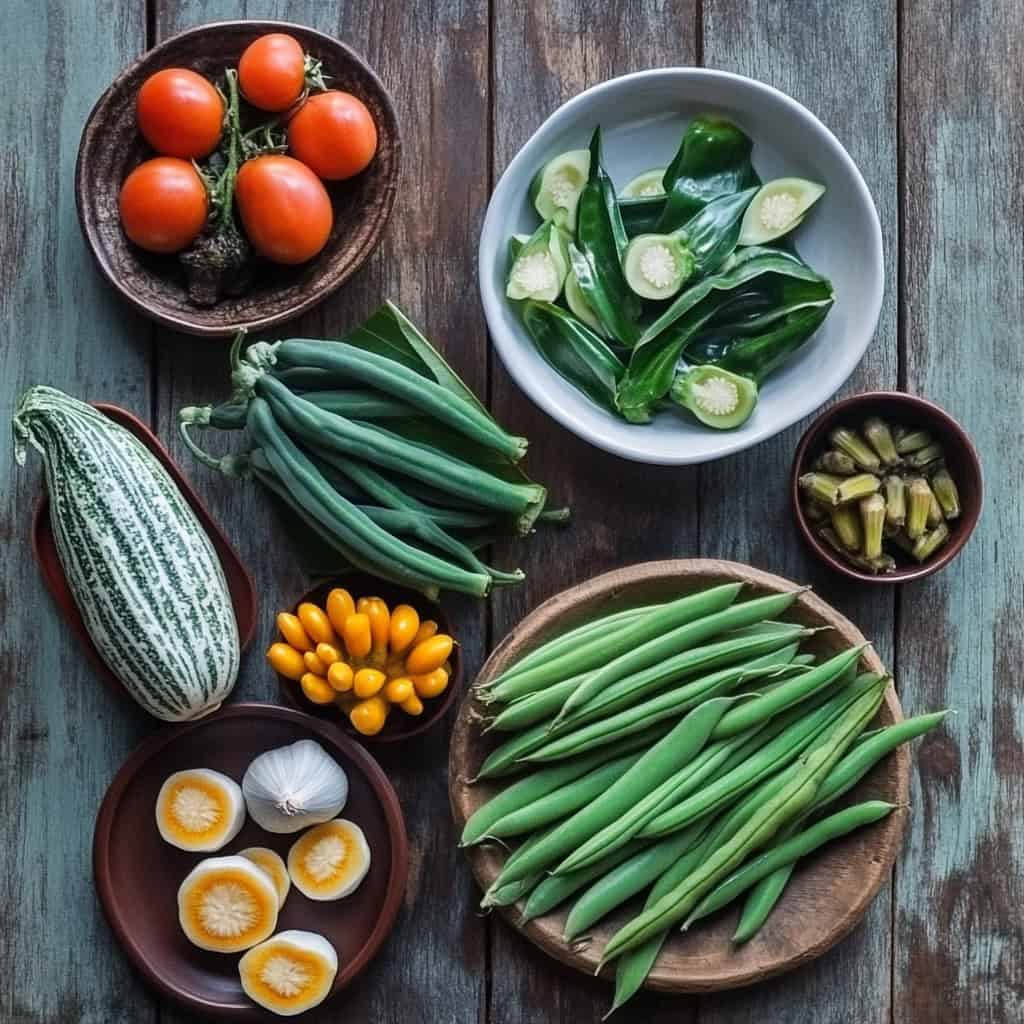
- 1 whole milkfish (bangus), scaled and cleaned
- Salt to taste
- Ground black pepper to taste
- 2-3 cups moringa leaves (malunggay)
- 2 cups squash flowers (bulaklak ng kalabasa)
- 12-15 pieces small to medium okra
- 1 bundle string beans (sitaw), cut into 3-inch pieces
- 2 medium bitter gourd (ampalaya), seeded and sliced
- 2 medium tomatoes, chopped
- 1 medium onion, chopped
- 1 thumb-sized ginger, sliced
- 2-3 tablespoons fermented fish sauce (bagoong isda)
- 3 cups water
Equipment
- Large Cooking Pot (Kaldero) - A deep pot with at least 5-quart capacity provides enough space for vegetables to cook evenly without overcrowding
- Grilling Pan or Grill - Essential for achieving the smoky flavor that defines authentic Dinengdeng; a stovetop grill pan works if outdoor grilling isn't possible
- Sharp Knife - Needed for precise vegetable preparation, particularly important when working with dense vegetables like bitter gourd
- Cutting Board - Provides a stable surface for safe and efficient ingredient preparation
- Measuring Spoons - Ensures the proper balance of bagoong isda, which can easily overpower the dish if not measured carefully
- Wooden Spoon - Allows gentle stirring that prevents vegetables from breaking apart during cooking
- Strainer - Used for thoroughly washing vegetables, especially important for leafy greens like malunggay
- Fish Grilling Basket (optional) - Helps prevent delicate fish from falling apart during the grilling process
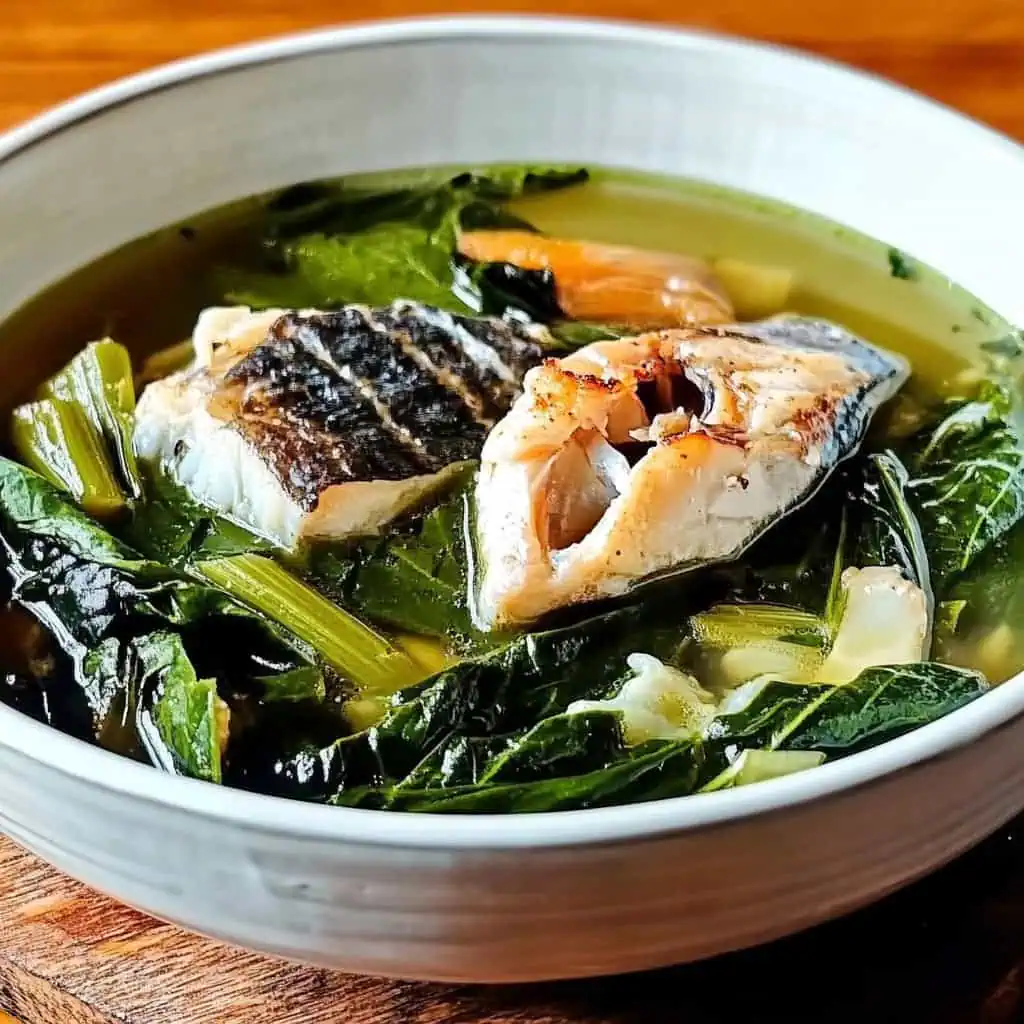
How To Make
- Prepare and Grill the Fish: Pat the milkfish dry with paper towels, maintaining the scales intact to prevent sticking. Season both sides generously with salt and pepper. Heat your grill to medium-high (375°F/190°C) and grill the fish for 7-8 minutes on each side until the skin is crispy and golden brown with visible grill marks. Set aside.
- Create the Aromatic Base: In a large pot, bring 3 cups of water to a rolling boil over high heat. Add the sliced ginger, chopped onions, and tomatoes. Cover the pot and let these aromatics simmer for 5 minutes, allowing them to release their essential flavors into the broth.
- Develop the Broth Flavor: Add the bagoong isda to the pot and stir well to fully incorporate it into the liquid. You'll notice the water taking on a slightly cloudy appearance with a rich, savory aroma—this is the foundation of your Dinengdeng's flavor.
- Cook Dense Vegetables First: Add the okra and string beans to the pot first, as these firmer vegetables require longer cooking times. Follow with the sliced ampalaya. Reduce to medium heat and cook for 7-10 minutes until these vegetables are almost tender while still maintaining their vibrant colors.
- Add Delicate Vegetables: Gently incorporate the squash flowers and malunggay leaves. Minimize stirring at this stage to preserve the integrity of these delicate vegetables. They need only 3-5 minutes to cook properly.
- Infuse with Fish Flavor: Place your grilled milkfish into the pot, allowing it to simmer gently for 3-5 minutes. This crucial step infuses the broth with the smoky essence of the grilled fish, completing the signature Dinengdeng flavor profile.
- Final Check and Serve: Your Dinengdeng is ready when all vegetables are tender but still have some structure (not mushy), and the broth is richly flavored. Serve hot in individual bowls over steamed white rice, allowing each person to add additional bagoong isda according to their preference.

Tips from Lola's Kitchen
- Grilling Secret: Keep the fish scales intact when grilling—they form a natural protective barrier that prevents the fish from sticking and falling apart.
- Vegetable Timing: Always add vegetables in order of cooking time—hardest first, most delicate last. This ensures each component is perfectly cooked.
- Nutrient Preservation: Don't overcook the malunggay leaves; they need just 2-3 minutes of heat to maintain their nutritional value and bright green color.
- Flavor Balance Check: Always taste your broth before adding the fish and make final adjustments to the bagoong isda quantity—once the fish is added, you'll want to minimize stirring.
- Ingredient Quality: While this dish is forgiving with substitutions, using the freshest vegetables possible makes a noticeable difference in the final flavor.
- Perfect Pairing: For an authentic experience, serve Dinengdeng with steamed rice and a small dish of additional bagoong isda on the side.
- Water Ratio: If you prefer a more concentrated flavor, start with 2.5 cups of water instead of 3, as the vegetables will release additional liquid during cooking.
- Fish Selection: Choose a medium-sized bangus (about 1-1.5 pounds)—too small won't provide enough flavor, too large may overwhelm the vegetables.
Substitutions
- Fish Options: If milkfish isn't available, substitute with tilapia, pompano, or any firm white fish that holds up well to grilling.
- Leafy Greens Alternative: No moringa leaves? Use spinach, water spinach (kangkong), or young sweet potato leaves as a nutritious substitute.
- Flower Substitute: Instead of squash flowers, you can use young squash tips, pumpkin shoots, or even thinly sliced zucchini.
- Sauce Alternative: If bagoong isda is unavailable, use fish sauce (patis) at about half the quantity, then adjust to taste—the flavor profile will differ slightly but still be delicious.
- Less Bitter Version: For those sensitive to bitterness, replace ampalaya with zucchini or chayote squash, or reduce the amount and balance with additional sweet vegetables.
- Okra Substitute: If okra is unavailable, green beans or even small broccoli florets can provide a similar textural element.
- Allium Options: Yellow or white onions work best, but shallots or even scallions can be used if needed.
Troubleshooting
- Too Bitter: If the ampalaya makes your soup too bitter, soak the sliced bitter gourd in salt water for 10-15 minutes before cooking, then rinse thoroughly. This draws out some of the bitterness.
- Too Salty: If you've added too much bagoong isda, add a peeled, quartered potato to the soup and simmer for 10 minutes—it will absorb excess salt. Remove before serving, or add more vegetables and water to balance the saltiness.
- Fish Breaking Apart: If your fish falls apart during cooking, consider using a fish grilling basket or grilling the fish separately and adding it only to individual serving bowls rather than the main pot.
- Vegetables Too Soft: Maintain a medium heat rather than a rolling boil, and track cooking times carefully. For delicate vegetables like malunggay, you can also add them directly to serving bowls and let the hot broth cook them just before eating.
- Cloudy Broth: A slightly cloudy appearance is traditional for Dinengdeng due to the bagoong isda. If you prefer a clearer broth, you can strain it before adding vegetables, though this will reduce some flavor complexity.
- Not Flavorful Enough: Let your aromatics (ginger, onion, tomato) simmer longer at the beginning, and ensure your fish is well-grilled to develop deeper, smokier flavors.
Storage & Reheating
- Refrigeration: Store leftover Dinengdeng in an airtight container in the refrigerator for up to 3 days. For best results, remove the fish and store it separately to prevent it from becoming overly soft.
- Preparation for Storage: Allow the soup to cool completely before refrigerating, but don't leave it at room temperature for more than 2 hours.
- Reheating Method: Gently reheat on the stovetop over medium-low heat until just hot enough to eat. Avoid boiling, which will make vegetables mushy and diminish flavors.
- Refreshing When Reheating: Add a small handful of fresh malunggay or other quick-cooking greens during reheating to brighten both flavor and nutritional content.
- Not Recommended for Freezing: The high water content in the vegetables means they'll become mushy when thawed, so freezing this dish isn't recommended.
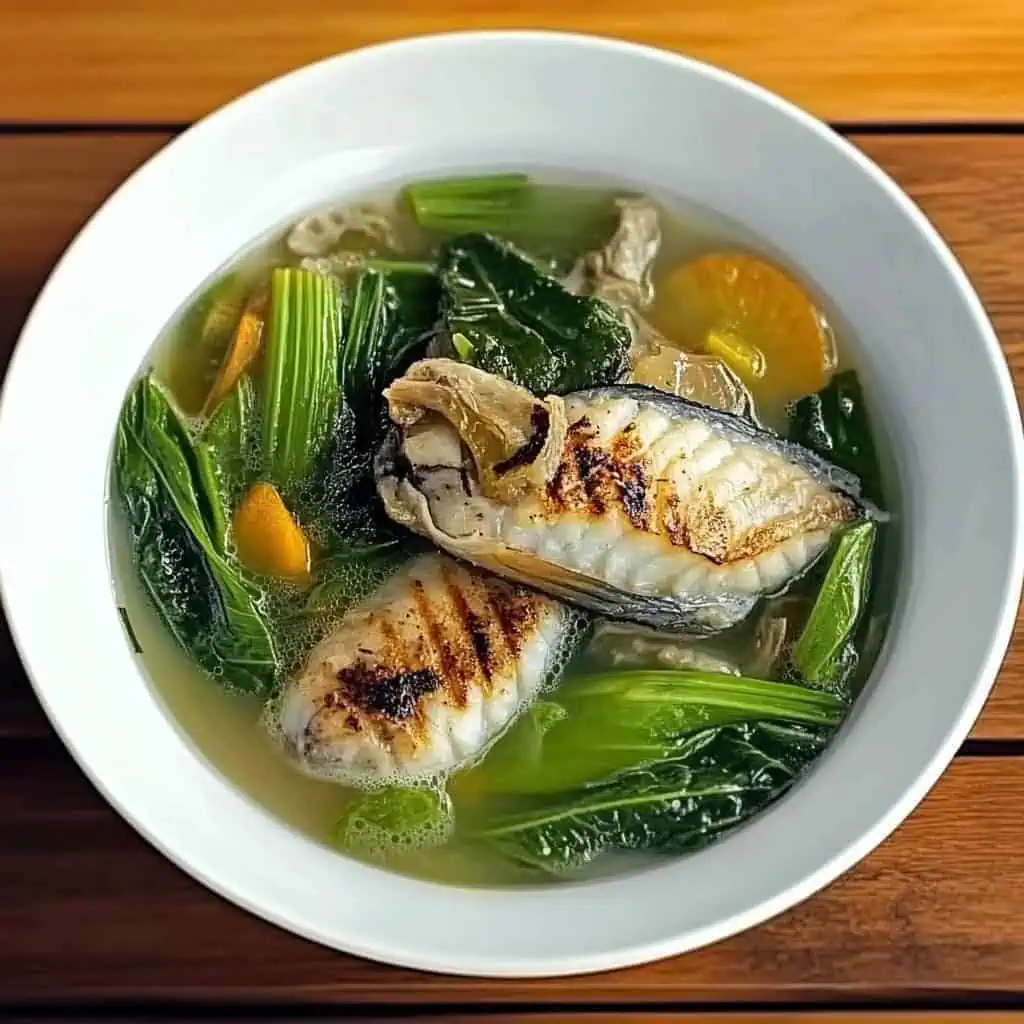
FAQ
Can I make this dish vegetarian?
Yes, you can create a vegetarian version by omitting the fish and replacing bagoong isda with vegetable stock enhanced with seaweed or mushroom sauce for umami. Add extra firm tofu grilled with liquid smoke for a similar smoky element.
How do I reduce the saltiness of bagoong isda?
Start with half the recommended amount (1-1.5 tablespoons) and gradually add more after tasting. You can also rinse the bagoong isda with a small amount of water before adding to reduce saltiness while retaining flavor.
Can I prepare the vegetables in advance?
Yes, you can clean and cut vegetables up to 24 hours ahead of time. Store them in separate containers in the refrigerator, with leafy greens wrapped in slightly damp paper towels to maintain freshness.
Why is my soup cloudy?
This is completely normal due to the proteins and minerals in the bagoong isda. The cloudiness actually indicates authentic flavor development and is traditionally expected in proper Dinengdeng.
Can I use an air fryer instead of grilling the fish?
Yes, you can air fry the bangus at 375°F for about 10-12 minutes. While it won't have the same smoky flavor as grilled, it will still be delicious. Consider adding a drop of liquid smoke to the broth to compensate.
How do I know when my vegetables are perfectly cooked?
Properly cooked vegetables should be tender enough to be easily pierced with a fork, yet still hold their shape. They should maintain vibrant color, once they turn dull, they're overcooked.
What makes Dinengdeng different from other Filipino vegetable soups?
Dinengdeng is distinguished by the combination of grilled fish and bagoong isda, whereas similar dishes like bulanglang or laswa typically use different protein sources or flavor bases.
Is this recipe suitable for meal prep?
It's best to consume Dinengdeng within 1-2 days for optimal flavor and texture. For meal prep, you can prepare the grilled fish and cut vegetables ahead of time, then assemble the soup fresh when needed.
Related
Looking for other recipes like this? Try these:
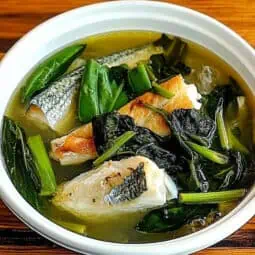
Authentic Ilocano Dinengdeng (Inabraw) Recipe
Equipment
- Large Cooking Pot (Kaldero) For cooking the vegetables and broth
- Grilling Pan or Grill (Ihawan) For grilling the fish
- Sharp knife (kutsilyo) For preparing vegetables
- Cutting board (Sangkalan) For safe ingredient preparation
- Measuring Spoons (Pansukat) For accurate seasoning
- Wooden spoon (sandok na kahoy) For gentle stirring of vegetables
- Strainer [Salaan] For washing vegetables
- Fish Grilling Basket (optional) For easier fish grilling
Ingredients
For the Grilled Fish:
- 1 whole milkfish bangus, scaled and cleaned
- Salt asin to taste
- Ground black pepper paminta to taste
For the Vegetables:
- 2-3 cups moringa leaves malunggay
- 2 cups squash flowers bulaklak ng kalabasa
- 12-15 pieces small to medium okra okra
- 1 bundle string beans sitaw, cut into 3-inch pieces
- 2 medium bitter gourd ampalaya, seeded and sliced
- 2 medium tomatoes kamatis, chopped
- 1 medium onion sibuyas, chopped
- 1 thumb-sized ginger luya, sliced
- 2-3 tablespoons fermented fish sauce
- 3 cups water tubig
Instructions
- Start by patting the milkfish dry with paper towels, keeping the scales intact to prevent sticking. Season both sides with salt and pepper. Heat your grill to medium-high (375°F/190°C) and grill the fish for 7-8 minutes on each side until golden brown. Once done, set aside.
- Fill a large pot with 3 cups of water and bring to a boil over high heat. Once boiling, add your sliced ginger, chopped onions, and chopped tomatoes. Cover the pot and let these aromatics cook for 5 minutes to release their flavors.
- Add the bagoong isda to the pot and stir well to combine with the broth. The water should now have a slightly cloudy appearance and a rich, savory smell.
- Add your okra and string beans to the pot. These harder vegetables need more time to cook. Next, add the sliced ampalaya. Reduce the heat to medium and let everything cook for 7-10 minutes until the vegetables are almost tender but still bright in color.
- Now add your squash flowers and malunggay leaves. These delicate vegetables only need 3-5 minutes to cook. Don't stir too much at this point to keep the vegetables intact.
- Finally, place your grilled milkfish into the pot and let it simmer gently for 3-5 minutes. This step is crucial as it allows the smoky flavor of the grilled fish to infuse into the broth.
- Your dinengdeng is ready when all vegetables are tender but not mushy, and the broth is flavorful. Serve hot in bowls over steamed rice. Each person can season their portion with additional bagoong isda if desired.
Tips from Lola's Kitchen
- Keep fish scales intact when grilling to prevent sticking
- Add vegetables in order of cooking time (hardest to softest)
- Don't overcook malunggay leaves to preserve nutrients
- Taste broth before adding fish - adjust bagoong as needed
- Use fresh vegetables for best results
Nutrition
The Story Behind Ilocano Dinengdeng
In the sun-soaked region of Ilocos, where vegetable gardens flourish in nearly every backyard, Dinengdeng emerged as a testament to Filipino resourcefulness and love for fresh, seasonal cooking. This beloved vegetable soup, also known as inabraw, represents the heart of Ilocano cuisine, where families have passed down the tradition of transforming everyday garden harvests into nourishing meals that bring people together.
What makes Dinengdeng stand out from other Filipino vegetable soups is its signature ingredient - perfectly grilled fish, typically bangus (milkfish), which adds a subtle smokiness to the light, savory broth. The dish's robust flavor comes from bagoong isda, a fermented fish sauce that's deeply rooted in Ilocano cooking traditions. Unlike its cousins bulanglang and laswa from other regions, Dinengdeng showcases how a single ingredient can transform a simple vegetable soup into a complete, satisfying meal.
The beauty of Dinengdeng lies in its flexibility. Traditional Ilocano families often gather whatever vegetables are ready for harvest - tender malunggay leaves, fresh okra, young string beans, bitter gourd, and seasonal squash flowers. This practice of cooking with available ingredients not only makes the dish economical but also ensures peak freshness and nutrition. It's this adaptability that has helped Dinengdeng remain a staple in Filipino homes, even as modern cooking trends come and go.
Today, Dinengdeng continues to tell the story of Filipino ingenuity in the kitchen. Whether served in humble homes or featured in restaurants celebrating Ilocano cuisine, this dish reminds us how our ancestors created sustainable, healthy meals long before these concepts became global food trends. It's more than just a soup - it's a celebration of fresh ingredients, family traditions, and the enduring appeal of honest, homestyle Filipino cooking.
For many Filipinos, especially those with Ilocano roots, Dinengdeng represents the taste of childhood Sunday lunches and family gatherings. The dish carries the wisdom of generations who understood that good food doesn't need to be complicated - it just needs to be prepared with care, using fresh ingredients and time-tested techniques that bring out the best in each component.
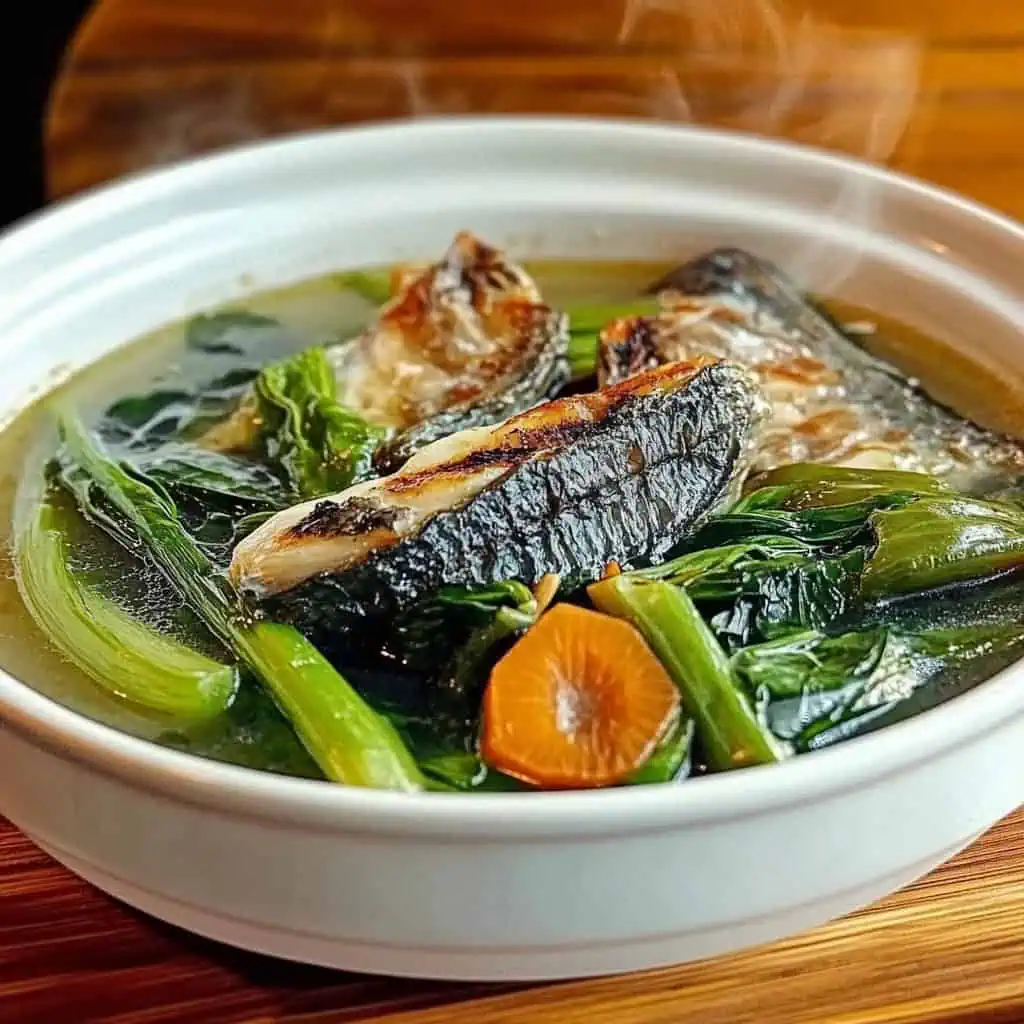


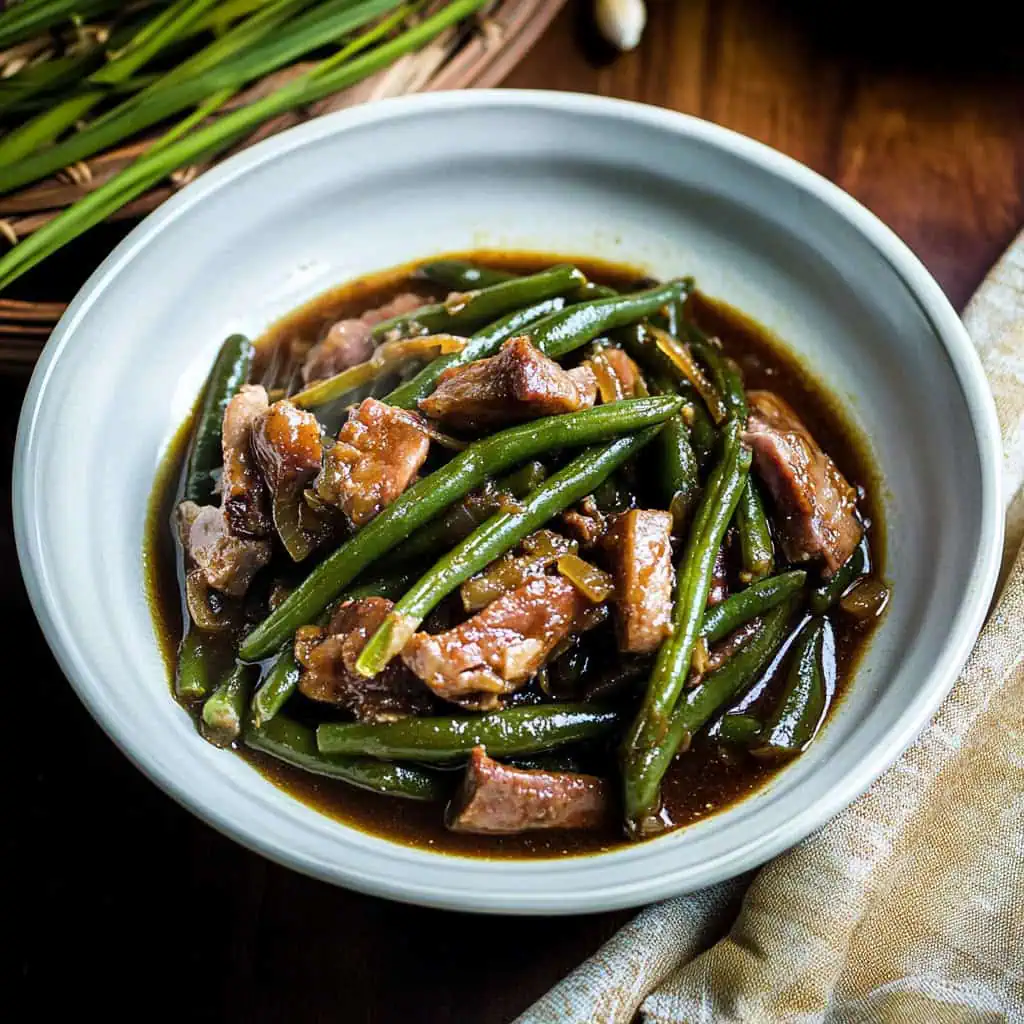

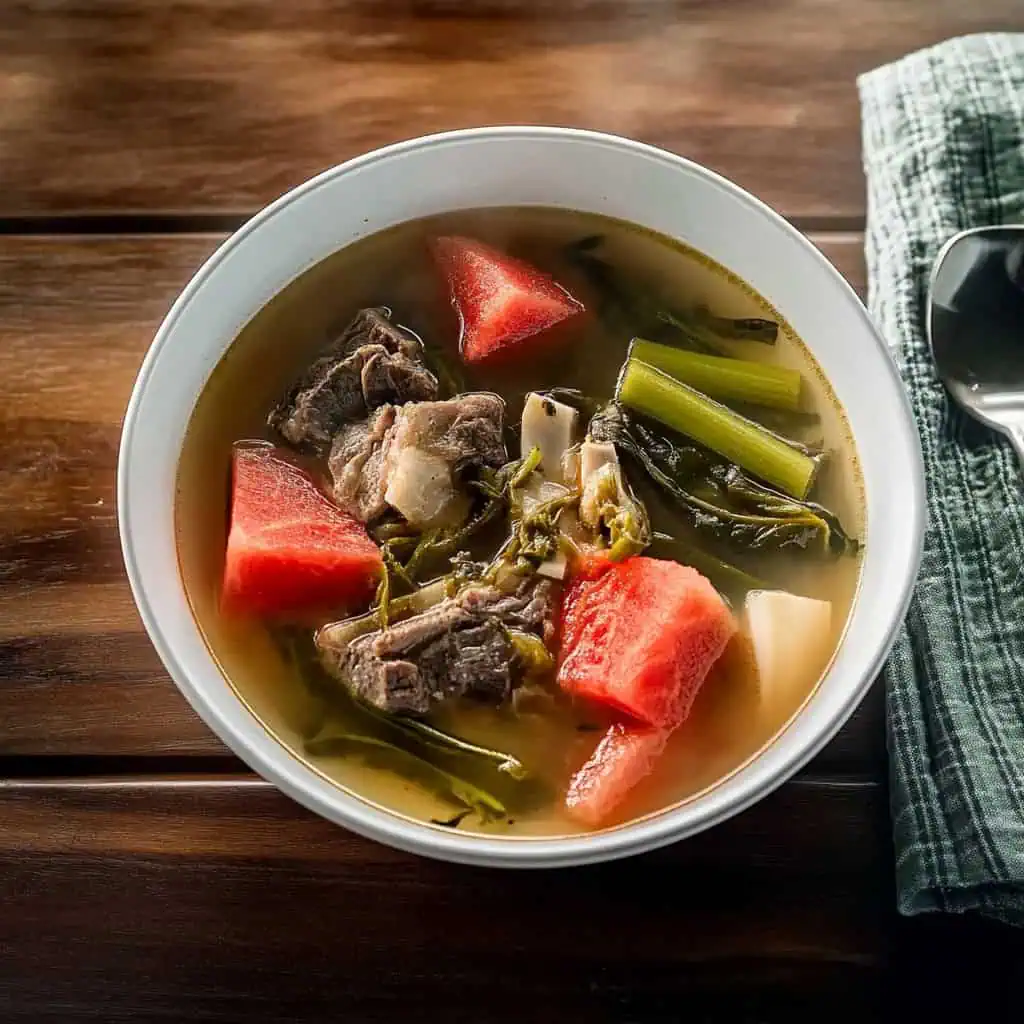
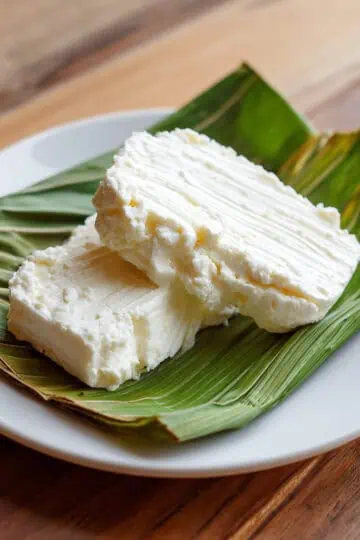
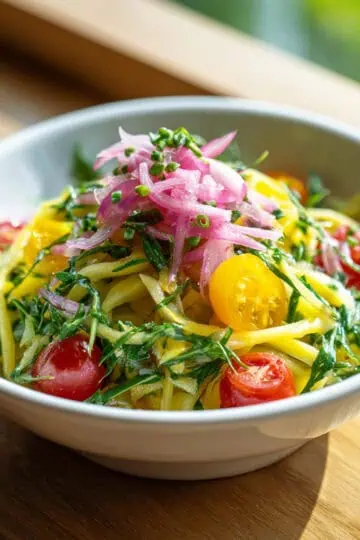
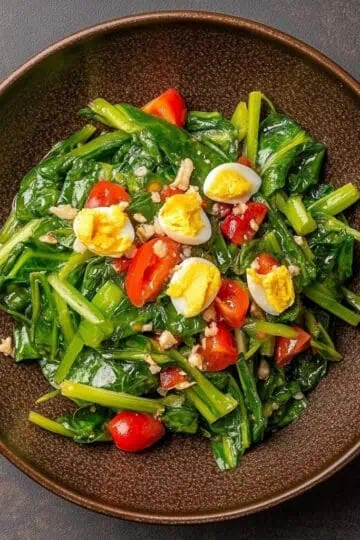

Comments
No Comments